What are the statutes of limitations?
Accounts receivable (RA) is the amount of debts and obligations of third parties to an enterprise or organization (creditor). Debtors (obligors) are obliged to repay the debt in accordance with the agreements. If this does not happen, the organization must apply to the court to protect its interests.
The statute of limitations for a loan is the period during which the creditor has the opportunity to file a statement of claim in court to protect his interests. The total value is usually 3 years. This means that after this time the debt is considered bad and cannot be paid. The countdown begins not from the moment debt obligations arise, but from the end of the deadline for repaying the debt under the terms of the contract.
To make legal proceedings go faster, it is recommended to seek help from specialists in the field of debt collection. A lawyer can act on behalf of a company under a contract. The process and final decision sometimes takes months.
It is worth noting that there are factors under which this period is interrupted. Among them are:
- the creditor went to court
- the debtor partially repaid the debt
- the debtor requested a deferment
- the debtor admitted the debt
The company must monitor debtors and monitor the status of debt. Problem debt is considered to be debt obligations that have not been fulfilled for more than 90 days.
The procedure for conducting remote sensing on video:
Wage arrears - sample debt certificate
The calculation and delivery of wages is the main condition for the existence of legal relations between employees and the employer. According to the key provisions of the Labor Law, every work must be paid.
Accordingly, the performance of work by a person on the basis of an agreement in the interests of the employer clearly gives rise to his obligation to pay for such work.
Each enterprise sets deadlines for calculating wages and advance payments, which cannot contradict the requirements specified by law. Therefore, staff must receive cash on these dates. However, wage arrears to the team often arise.
What are the grounds for writing off debt?
The grounds for writing off debt are:
- debtor bankruptcy
- inability to locate the debtor
- death (if we are talking about an individual)
- liquidation of a company (if we are talking about a legal entity)
Also, a debt is considered hopeless if the impossibility of satisfying it is established by a resolution of the bailiff.
A large organization that collaborates with a large number of people and other companies often has debtors. Bad debts are taken into account and written off in order to reduce the tax burden on profits.
Accounting for write-offs
Accountants write off accounts receivable. The procedure follows a certain algorithm. The following actions are performed:
an inventory order is created- certificate is filled out
- the manager creates an order
Only those debts that cannot be collected can be written off. The inventory report is accompanied by documents indicating the reality of the transaction, and papers confirming the bad debt (a bailiff's decree will do).
In accounting, the company’s responsibilities necessarily include compiling a specialized reserve for doubtful debts. The organization is required to retain debt write-off documents for 5 years. After this period of time, the debt is considered permanently written off.
Tax accounting for write-offs
When maintaining tax records, creating a reserve for doubtful debts is considered an optional procedure. If there is no reserve, then the debt is written off for non-operating expenses. If it is available, then the write-off of the receivables is carried out at the expense of the reserve.
Only companies that calculate their income tax liability using the accrual method have the opportunity to write off debt that cannot be collected as expenses. Organizations that keep records in another way cannot do this.
Carrying out a debt check
The company must regularly check the data when creating reports. As a rule, verification is performed during a debt inventory. Obtaining information is necessary to assess the property and financial situation, determine the amount of available cash, and take measures to control debts.
Before drawing up most reports, a debt review is carried out. It is worth noting that a rapid increase in receivables indicates unreliability of counterparties or a significant increase in unnecessary expenses.
During the inspection, an information paper about the remote control is drawn up. It can be compiled for internal or external use. The document is created and filled out according to the sample or in free form.
Form and content
Required sample of accounting certificate for court
can be drawn up in the most general form, since the law does not establish either a mandatory or recommended form of this document.
The main thing is that it contains accurate, legally competent and relevant references to the provisions of the law, and also provides accessible reference data that the company wants to confirm or refute in court.
Please note that recently courts are increasingly accepting accounting statements drawn up in free form as appropriate evidence in a particular dispute.
Keep in mind (!): Article 313 of the Tax Code directly calls an accountant’s certificate (along with other “primary documents”) a document confirming tax accounting. And any court has no right to ignore this normative rule. Including on the grounds that the law does not establish a mandatory form for such a certificate.
Any accounting certificate for the court
It is better to prepare on the organization’s letterhead.
Keep in mind:
It is not at all necessary to refer in this certificate to the fact that it is issued specifically for judicial purposes. But it is very desirable for it to be signed not only by the chief accountant, but also by the head of the organization. This will give the certificate evidentiary weight in court.
Functions of help about remote sensing
The certificate for internal use is used for reporting. With its help, the current situation of the organization is monitored and assessed. Paper intended for external use is attached to the statement of claim and is used in legal proceedings.
The paper can also be drawn up at the request of other persons and government bodies. The data can be used to evaluate existing assets. The certificate is often requested by insurers and other creditors.
When using the sample, no problems with drawing up the document arise. An experienced accountant, having access to all the data, takes very little time to compile a certificate.
Legal basis
The legislation does not provide recommendations on the choice of a specific form of certificate to reflect the PD. When compiling, you can use different samples depending on your goals and objectives. Most often, when drawing up a document, the INV-17 form is used. Ultimately, the paper should reflect detailed information about the loan agreement, the reporting period, the amount of obligations and other nuances.
The certificate is always compiled by the organization itself for internal or external use. An organization can use its own sample certificate, which is created from scratch or built on the basis of an existing form.
Fill out the certificate in form KR-7
First of all, you need to provide the following information:
- Name of the business entity.
- Name of the structural unit.
- Organization code according to OKPO.
- TIN.
- Code of type of activity according to OKDP.
- Type of operation.
- Certificate number and date of its preparation.
- The period for which the calculation is made.
Next you need to fill out the table. What you need to indicate:
- Serial number of the record.
- The name of the trading organization (the store that sold the goods on credit to the employee) and its OKPO code.
- Obligation order number.
- Full name of the employee and his personnel number.
- The balance of debt under this instruction-obligation.
At the end of the table you need to summarize all debts. After this, the employee who compiled the certificate signs, and then the one who checked it.
Classification of certificate forms
Typically, classification is carried out based on the purpose of the paper. The document can be used in the following cases:
- to create swelling
- to provide information about current receivables for other persons
- during legal proceedings
A plaintiff who attaches a certificate of confidentiality to his claim significantly increases the likelihood that the court will satisfy the requirements specified in the claim. The certificate acts as one of the documents that confirms the existence of debt obligations of the defendant to the plaintiff.
Regardless of the purpose of creation, the universal form INV-17 can almost always be used for compilation. The template is freely available, so anyone can use it.
Types of document
There are many types of certificates about the presence or absence of debt. Depending on which organization issues it, where such a certificate may be required, the forms and details of the document differ. Let's look at the most popular of them.
By salary
Despite the fact that labor legislation enshrines the employer’s obligation to pay employees on time, delays in wages and the formation of debt on them are quite common phenomena. Most often, such delays are irregular and short-term, and employees soon receive the payment due to them.
But it also happens that workers wait for their money for several months and even six months and a year. In such a situation, they may decide to leave the organization, and in order to receive the money they have earned, they must file a complaint with the labor inspectorate, the prosecutor's office or the court. Then they will need a certificate of arrears of wages, which must be given to them free of charge upon request; the employer has no right to refuse to issue it.
The document is drawn up in any form; the chief accountant and the head of the enterprise are responsible for the correctness and completeness of the information in it. It is their two signatures that should be on the certificate. In addition, it should contain the following information:
- information about the organization (name, details, address);
- information about the employee (full name, position, salary, total period of work at the enterprise and the period when there was no payment);
- amount of actual debt.
Certificate of wage arrears to employees
For taxes
The applicant can receive one of two types of certificates from the tax authorities:
- on the fulfillment of the obligation to pay taxes;
- about the status of tax payments.
The first type of certificate can be considered a document confirming the presence or absence of tax debt, but it will not contain information about its amount. The status of settlements as of the current date for all types of taxes, fees, fines and penalties will be reflected in the second certificate.
A certificate of the presence (absence) of debt issued by the tax office will contain the entry: “has an unfulfilled obligation...” or “does not have an unfulfilled obligation.” The form of the certificate is established by order of the Federal Tax Service. According to the regulations, the document is issued free of charge within ten days after registration of the taxpayer’s request. The following may refuse to issue a certificate:
- if the application sent via telecommunication channels is not signed with an electronic signature or it is not confirmed;
- if the applicant does not have a power of attorney from the organization;
- if the text of the application is impossible to read.
Certificate from the tax office confirming payment of taxes
Such a certificate may be needed to verify counterparties, when participating in tenders or to obtain a loan.
Documents for obtaining a certificate of no tax arrears are described in this video:
For accounts receivable
An enterprise often has accounts receivable when buyers, customers and other persons - debtors - owe it money. The size of this debt is determined as a result of the work of the inventory commission. The inventory procedure is formalized by an inventory act in form No. INV-17 and a certificate to the act, which, in essence, will be a certificate of the presence (absence) of receivables.
Compiled in the context of synthetic accounting accounts, a certificate of settlements with buyers, suppliers and other debtors and creditors is made in two copies, one is stored in the accounting department of the organization, the other is kept by the inventory commission.
Sample certificate of accounts receivable and payable
The document is a mandatory document in accounting, and is drawn up annually to write off bad receivables. Can serve as evidence in court if a creditor files a lawsuit to recover funds from the debtor.
For overdue debt
Overdue loan debt is also a fairly common phenomenon among bank clients. If a borrower, due to the deterioration of his financial situation, does not pay his loan for a long time, he develops overdue debt, which spoils his credit history. All banks now submit lending data to a common database on the basis of which the NBKI (National Bureau of Credit Histories) operates.
NKBI data is publicly available. If the borrower decides to take out another loan, the bank can check his solvency by looking at his credit history. Seeing the presence of overdue debt there, the credit institution will refuse such a client, even if in fact the old loan is already closed. NKBI databases are often out of date. Therefore, after repaying the overdue debt, it is better for the borrower to take such a certificate.
The document is issued by the bank that issued the loan. The certificate is called “Confirmation of the absence of overdue debt on the borrower’s loan” and is drawn up according to standard form No. 10-040.
Almost any correctly executed certificate of the presence or absence of debt can serve as evidence in court. For example, during a court hearing of a debt collection case, the defendant can prove that he has no debts with the help of such a certificate.
For loan debt
The loan debt is the amount of the remaining debt. There are times when it needs to be confirmed. For example, a citizen took out a long-term mortgage loan from a bank to purchase a home.
Due to the fact that he is an officially working citizen paying personal income tax, he has the right to receive a property deduction. The package of documents required to obtain it may include a certificate of absence of loan debt to confirm that payments have been made.
Certificate of absence of loan debt
For accounts payable
Accounts payable are closely related to accounts receivable when it comes to obligations of the same individuals to each other. Accounts payable are subtracted from accounts receivable if counterparties have counter debts.
Therefore, the previously described inventory act in form No. INV-17 and the attached certificate of settlements with creditors and debtors reflect both types of these debts. Documents may be required, for example, during enterprise reorganization, merger or change of owners.
Before the budget
You can obtain a certificate from the tax office about the status of settlements with the budget. It will reflect information on all types of taxes, fees, fines, penalties, contributions for which the taxpayer may be in debt to the budget, as well as on amounts. In this way, this certificate differs from other tax certificates, which contain only a record of the presence or absence of debts on taxes and fees.
As in the previous example, a certificate is often required when participating in tenders, checking counterparties, concluding contracts and taking out loans. The form of both such certificates, which can be obtained from the tax office, was approved by Order of the Federal Tax Service dated December 28, 2016 No. ММВ-7-17/ The document preparation period is 5 working days.
For utility bills
Not everyone pays utility bills in good faith; for some, this is a sore subject. However, it is often necessary to confirm the absence of utility debts in various situations. Most often this is necessary when making real estate transactions. Potential buyers or tenants want to receive proof of the absence of utility debts, so that later they do not have to pay off other people’s debts.
This certificate is not mandatory for the sale or privatization of housing; it is done at the request of the purchaser, therefore its form is not strictly regulated. Its recommended form can be called the EIRTs-22 form. You can obtain the document at the Unified Settlement Center, where people most often pay for housing and communal services.
Rent arrears (certificate)
The video below will tell you what a certificate of absence of debt for housing and communal services is and how it is made:
A certificate about the presence (absence) of debt in a bank is often needed for another bank. Therefore, it is best to immediately confirm any closed loan with such a certificate.
Thus, the client will have in his hands all the evidence of the absence of overdue or outstanding debt on loans. The procedure for issuing these certificates is not established by law, so various banks themselves set the amount of the fee for it and the timing of receipt.
Rules for issuing a certificate
Among the basic design rules are:
indication of information about the amount of obligations, the name of the creditor and debtor and the period of occurrence of the debt- filling in information based on inventory results
- use of a single template if the organization has approved a specific template
- paying attention to the purpose of the paper
For internal use, a document may be drawn up that additionally includes information about accounts payable. Such paper will allow you to obtain more data about the financial condition of the company, its assets and debts.
Types of document
There are many types of certificates about the presence or absence of debt. Depending on which organization issues it, where such a certificate may be required, the forms and details of the document differ. Let's look at the most popular of them.
By salary
Despite the fact that labor legislation enshrines the employer’s obligation to pay employees on time, delays in wages and the formation of debt on them are quite common phenomena. Most often, such delays are irregular and short-term, and employees soon receive the payment due to them.
But it also happens that workers wait for their money for several months and even six months and a year. In such a situation, they may decide to leave the organization, and in order to receive the money they have earned, they must file a complaint with the labor inspectorate, the prosecutor's office or the court. Then they will need a certificate of arrears of wages, which must be given to them free of charge upon request; the employer has no right to refuse to issue it.
The document is drawn up in any form; the chief accountant and the head of the enterprise are responsible for the correctness and completeness of the information in it. It is their two signatures that should be on the certificate. In addition, it should contain the following information:
- information about the organization (name, details, address);
- information about the employee (full name, position, salary, total period of work at the enterprise and the period when there was no payment);
- amount of actual debt.
Certificate of wage arrears to employees
For taxes
The applicant can receive one of two types of certificates from the tax authorities:
- on the fulfillment of the obligation to pay taxes;
- about the status of tax payments.
The first type of certificate can be considered a document confirming the presence or absence of tax debt, but it will not contain information about its amount. The status of settlements as of the current date for all types of taxes, fees, fines and penalties will be reflected in the second certificate.
A certificate of the presence (absence) of debt issued by the tax office will contain the entry: “has an unfulfilled obligation...” or “does not have an unfulfilled obligation.” The form of the certificate is established by order of the Federal Tax Service. According to the regulations, the document is issued free of charge within ten days after registration of the taxpayer’s request. The following may refuse to issue a certificate:
- if the application sent via telecommunication channels is not signed with an electronic signature or it is not confirmed;
- if the applicant does not have a power of attorney from the organization;
- if the text of the application is impossible to read.
Certificate from the tax office confirming payment of taxes
Such a certificate may be needed to verify counterparties, when participating in tenders or to obtain a loan.
Documents for obtaining a certificate of no tax arrears are described in this video:
For accounts receivable
An enterprise often has accounts receivable when buyers, customers and other persons - debtors - owe it money. The size of this debt is determined as a result of the work of the inventory commission. The inventory procedure is formalized by an inventory act in form No. INV-17 and a certificate to the act, which, in essence, will be a certificate of the presence (absence) of receivables.
Compiled in the context of synthetic accounting accounts, a certificate of settlements with buyers, suppliers and other debtors and creditors is made in two copies, one is stored in the accounting department of the organization, the other is kept by the inventory commission.
Sample certificate of accounts receivable and payable
The document is a mandatory document in accounting, and is drawn up annually to write off bad receivables. Can serve as evidence in court if a creditor files a lawsuit to recover funds from the debtor.
For overdue debt
Overdue loan debt is also a fairly common phenomenon among bank clients. If a borrower, due to the deterioration of his financial situation, does not pay his loan for a long time, he develops overdue debt, which spoils his credit history. All banks now submit lending data to a common database on the basis of which the NBKI (National Bureau of Credit Histories) operates.
NKBI data is publicly available. If the borrower decides to take out another loan, the bank can check his solvency by looking at his credit history. Seeing the presence of overdue debt there, the credit institution will refuse such a client, even if in fact the old loan is already closed. NKBI databases are often out of date. Therefore, after repaying the overdue debt, it is better for the borrower to take such a certificate.
The document is issued by the bank that issued the loan. The certificate is called “Confirmation of the absence of overdue debt on the borrower’s loan” and is drawn up according to standard form No. 10-040.
Almost any correctly executed certificate of the presence or absence of debt can serve as evidence in court. For example, during a court hearing of a debt collection case, the defendant can prove that he has no debts with the help of such a certificate.
For loan debt
The loan debt is the amount of the remaining debt. There are times when it needs to be confirmed. For example, a citizen took out a long-term mortgage loan from a bank to purchase a home.
Due to the fact that he is an officially working citizen paying personal income tax, he has the right to receive a property deduction. The package of documents required to obtain it may include a certificate of absence of loan debt to confirm that payments have been made.
Certificate of absence of loan debt
For accounts payable
Accounts payable are closely related to accounts receivable when it comes to obligations of the same individuals to each other. Accounts payable are subtracted from accounts receivable if counterparties have counter debts.
Therefore, the previously described inventory act in form No. INV-17 and the attached certificate of settlements with creditors and debtors reflect both types of these debts. Documents may be required, for example, during enterprise reorganization, merger or change of owners.
Before the budget
You can obtain a certificate from the tax office about the status of settlements with the budget. It will reflect information on all types of taxes, fees, fines, penalties, contributions for which the taxpayer may be in debt to the budget, as well as on amounts. In this way, this certificate differs from other tax certificates, which contain only a record of the presence or absence of debts on taxes and fees.
As in the previous example, a certificate is often required when participating in tenders, checking counterparties, concluding contracts and taking out loans. The form of both such certificates, which can be obtained from the tax office, was approved by Order of the Federal Tax Service dated December 28, 2016 No. ММВ-7-17/ The document preparation period is 5 working days.
For utility bills
Not everyone pays utility bills in good faith; for some, this is a sore subject. However, it is often necessary to confirm the absence of utility debts in various situations. Most often this is necessary when making real estate transactions. Potential buyers or tenants want to receive proof of the absence of utility debts, so that later they do not have to pay off other people’s debts.
This certificate is not mandatory for the sale or privatization of housing; it is done at the request of the purchaser, therefore its form is not strictly regulated. Its recommended form can be called the EIRTs-22 form. You can obtain the document at the Unified Settlement Center, where people most often pay for housing and communal services.
Rent arrears (certificate)
The video below will tell you what a certificate of absence of debt for housing and communal services is and how it is made:
A certificate about the presence (absence) of debt in a bank is often needed for another bank. Therefore, it is best to immediately confirm any closed loan with such a certificate.
Thus, the client will have in his hands all the evidence of the absence of overdue or outstanding debt on loans. The procedure for issuing these certificates is not established by law, so various banks themselves set the amount of the fee for it and the timing of receipt.
Instructions for compilation
In order to properly issue a certificate, it is advisable to draw it up according to a ready-made sample. The template contains individual thematic blocks. The following information must be reflected in the paper:
detailed name of the debtor- reason for accrual of debt (provision of services, sale of goods)
- Date the debt arose
- name of the papers damaging the existence of the debt (act of work performed or transfer of goods)
- amount of debt
The details of the persons responsible for drawing up the certificate are also indicated. If necessary, an additional column is created in which special tags or individual comments can be placed. In addition to signatures, the organization’s seals are affixed to the certificate.
Form and required details
Since this is a primary document, two important conditions must be met:
- The form and procedure for compilation must be prescribed in the accounting policies of the organization.
- Availability of the mandatory details provided for in Article 9 of the Federal Law of December 6, 2011 No. 402 on accounting.
If an organization can develop the form on its own or use a sample for filling out an accounting certificate (0504833), which was developed and approved by Order of the Ministry of Finance dated March 30, 2015 No. 52n for government institutions, then the requirements for the details are quite strict. The form must include:
- name of the organization;
- document number and date of its preparation;
- title of the document;
- the content of the reflected fact of economic life;
- units of measurement and method of reflection (monetary or natural);
- data from other primary documents (if necessary);
- position and full name the person who performed the operation;
- signature of the compiler.
Only if these requirements are met will the completed form be considered valid.
How to get
The certificate is usually compiled by a senior economist or financial director of the company. An organization can use third-party help from specialists when creating reports and drawing up certificates of remote sensing.
Within the company, the paper is filled out when reporting or at the request of management. Controlling and supervisory authorities do not have the right to require the provision of a certificate of PD. If desired, the organization provides paper on a voluntary basis.
Features of filling in a legal dispute
In the certificate that will be used in court proceedings, it is recommended to additionally indicate the following information:
- detailed details of your own company
- date of compilation
- manager's signature
Sometimes additional information about the destination (name of the court) is added to the paper for the court. Signatures of members of the commission that conducted the inventory may also be required.
The certificate duplicates the information from the reporting, providing data in a compressed form. A correctly drawn up paper will help you count on receiving a positive decision in a dispute related to debt collection.
Large companies are recommended to have their own lawyer on staff in order to resolve debt problems as quickly as possible. The statement of claim must clearly reflect the organization's requirements and refer to available documents confirming the debt to the plaintiff.
How to fill out the sample correctly?
Certificates of debt are issued by authorized organizations or government bodies. But for this it is necessary to draw up the application correctly, so as not to subsequently receive a refusal to issue a certificate. Samples are issued by the organizations themselves, where you need to obtain the document. It is recommended to provide only accurate information, and all words must be readable.
As an example, let’s consider a certificate confirming the absence or presence of debt of the organization to employees. The certificate states:
- Employer's name.
- Date of preparation of the certificate.
- The presence or absence of debt. If available, then either the full amount or a broken down amount is indicated.
- Passport details of the author of the certificate. This is necessary so that in case of any inaccuracy, there is a connection with the compiler himself.
Sample
A certificate of debt can play a big role in court, proving that one party has fulfilled its obligations and the other has not. It should be understood that it is worth obtaining the document from authorized organizations.
Supporting papers for going to court
Only a certificate of confidentiality is not enough for the court to take the plaintiff’s side. The following documents must be submitted along with the claim:
- contracts concluded with the counterparty (supply of goods, provision of services, etc.)
- invoices
- signed acts
- invoices
It is documents confirming that the company provided certain services to the other party or transferred goods that play a critical role in debt collection.
After receiving a positive result, the federal bailiff service is responsible for the execution of the court decision. If the debtor refuses to fulfill his obligations under the contract, it is recommended to try to resolve the issue in court as quickly as possible. It is advisable that all actions be carried out within 1 year, when the debt is still considered problematic and not hopeless.
Certificate of ownership is an important document that is required for both internal and external use. Drawing up a document does not require much time. There are no strictly regulated samples, but it is recommended to use common and unified templates.
Top
Write your question in the form below










